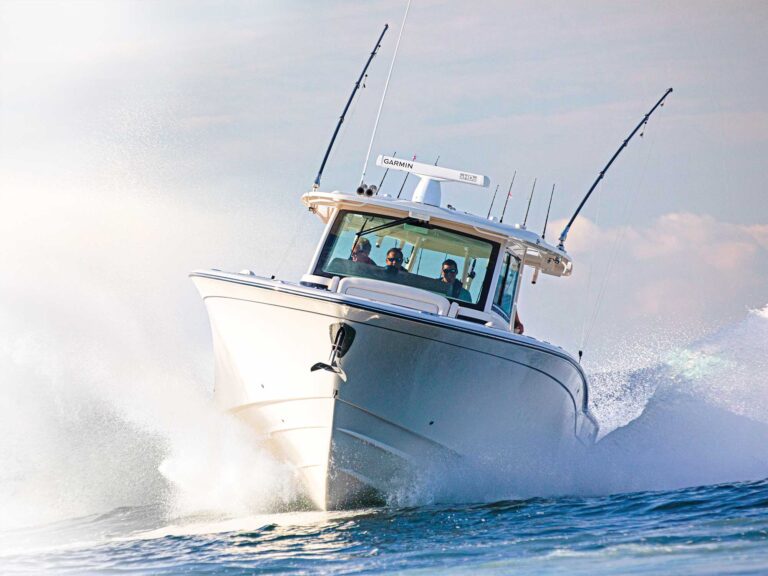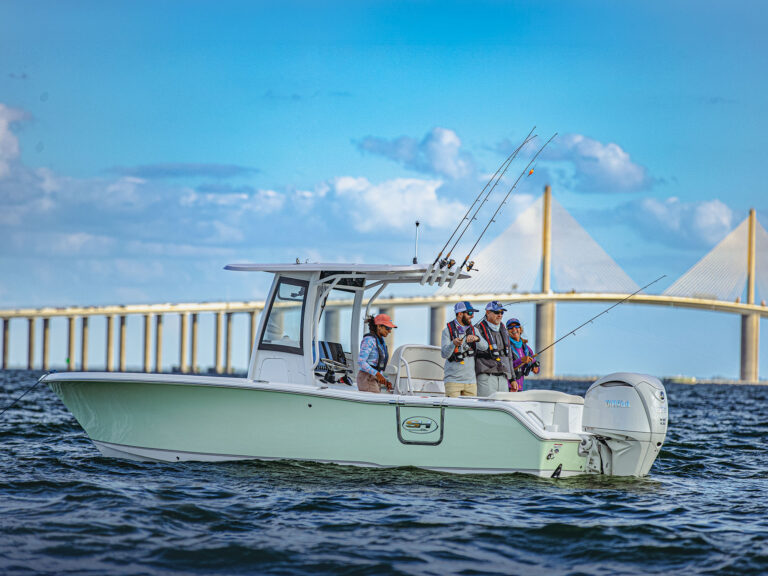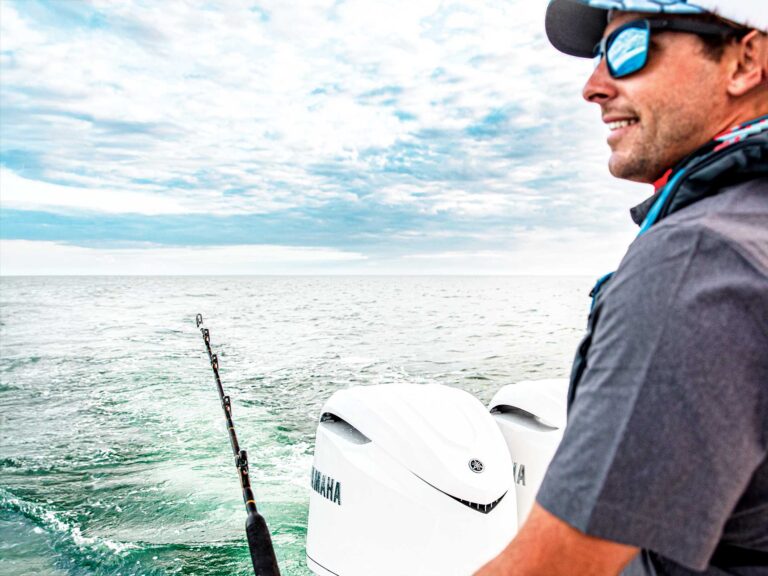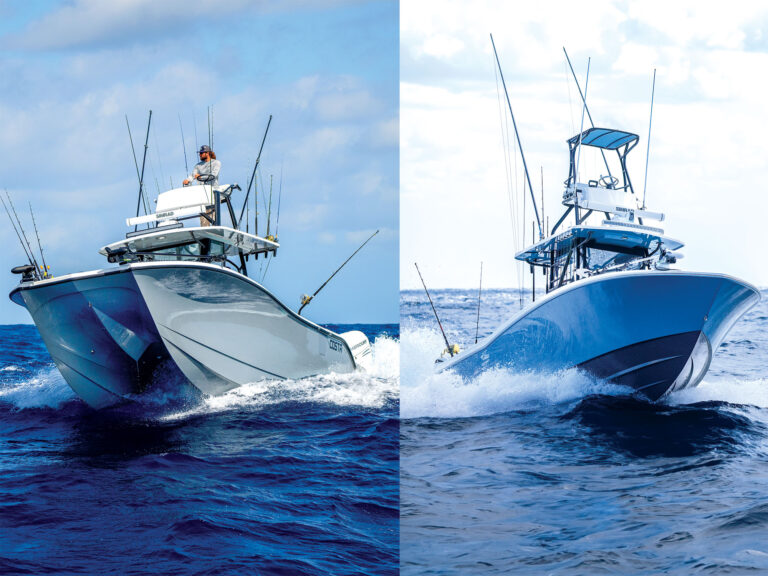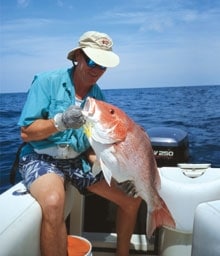
|| |—| || |ROCK HOUNDS: Offshore rock piles are lidely places to jig up heavy red snapper. Photo: Robert Sloan| We were idling away from the dock at Port Mansfield, Texas, aboard Captain Frank Vasquez’s big Mako when the three outfits in the rocket launcher caught my attention. It wasn’t so much the rods, but rather the silver, chartreuse and orange diamond jigs attached to them.
“What’s up with the jigs?” I asked.
Before Vasquez could answer Mark Davis of Shakespeare Fishing Tackle pulled one of the rods from the holder, palmed the jig and held it up.
“This is a fish-catching machine,” said Davis, a veteran offshore angler along the Gulf Coast. “The rocks we’re heading to right now are loaded with snapper and grouper, and one of the best ways to catch them is with these jigging spoons.” Vasquez knowingly eyed the diamond jigs and smiled.
We made the run from the Laguna Madre, passed the Mansfield jetties and headed east about 22 miles. As we reached our destination, Vasquez eased back on the throttles and watched his depth finder.
“That’s what we’re looking for,” he said, pointing to the screen that showed a small cluster of rocks, 68 feet below the boat. “I’ll hold us here. You guys get ready to drop those jigs. Let them all touch the bottom, reel up about three feet and start working them up and down.”
I flipped the reel into free-spool and let the six-ounce jig zip toward the bottom. It didn’t take long for the action to begin. On our first three drops we connected with two strawberry grouper and a fat red snapper weighing about 12 pounds. Davis hauled the snapper aboard, with the chartreuse jigging spoon dangling from its lower jaw.
“See what I mean,” he said.
A Jig for All Seasons
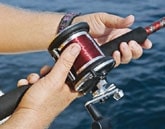
| |
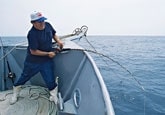
| |Keeping contact with the line means being able to feel the slightest bump (top). Pulling snapper and gropuer up from the deep requires a stout rod (bottom). Photo: Robert Sloan| We found out in a hurry that jigging over those rocks was a way to ice quick limits of snapper and grouper. It’s a tactic that works well around various types of structure, such as wrecks, rocks and alongside the subsurface structure of oil and gas production rigs in the Gulf of Mexico. Perhaps best of all, it can be productive year-round. Both spoons and nylon jigs are effective, providing almost limitless options of weight, color, shape and action.
Captain Peace Marvel, who runs Reel Peace Charters out of Venice, Louisiana, keeps a good supply of both diamond jigs and hair jigs on his boat.
“If you want to catch snapper, drop a nylon jig down that’s tipped with a whole pogy,” says Marvel. “But if you want a chance to catch grouper and snapper, drop a 16-ounce diamond jig down to the bottom and work it back up slowly. If a big grouper or snapper is down there, it’s going to eat the diamond jig for sure.”
A lot of anglers along the Gulf Coast prefer to tip a jig with some sort of dead bait. Whole pogies work well and are almost always available at local marinas and bait camps in 25-pound boxes. To save some money, locate a bait dealer that sells to commercial fishermen. I prefer to buy a 100-pound crate of frozen pogies. Once they begin to thaw I’ll package them in two-gallon plastic bags and store them in a chest freezer. I save a lot of money that way. Other options for tipping jigs include teasers, such as bonito strip baits, whole cigar minnows, Spanish sardines or a chunk of squid. The only downside to teaser baits is that you’ll get a whole lot of bites from sharks, bonito, king mackerel and barracuda. Not that there is anything wrong with catching those fish, but they have a tendency to cut you off and steal a jig. And that can turn into a costly deal.
Nylon Needs
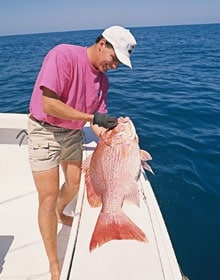
| |RED ZONE: gulf wrecks, reefs and oil rigs provide excellent structure for jigging hefty snapper. Photo: Robert Sloan| Whereas some anglers prefer diamond jigs, others opt for nylon. When Dr. Curtis Thorpe, of Beaumont, Texas, is not working as an orthopedic surgeon, you can usually find him in his 36-foot Contender, Muy Loco, jigging for grouper and trophy-class snapper out of Sabine Pass. His speciality is working nylon hair jigs around wrecks, rocks and rigs.
“A diamond jig is fine, but over the years I’ve found that Snapper Slapper nylon jigs catch more fish on a regular basis,” says Thorpe. “You can fish them right out of the package. But my preference is to tip them with a whole pogy fresh off the ice. Snapper Slapper jigs come with an optional snap-on trailer hook that has saved a lot of big fish for me.”
Snapper Slapper jigs come in many sizes. Thorpe says his favorites are the three-, five- and seven-ounce jigs. The Snapper Slapper’s bullet-shaped head with flared fins on either side imitates a squid. The three-ounce jigs are about five inches long, and the seven-ouncers are eight inches long. They are big jigs designed for catching big snapper and grouper.
“The weight of the jig I use depends on how strong the current is,” says Thorpe. “The main thing is to be able to fish the jig close to the structure.
For grouper you almost have to be bouncing the jig off the wreck or rock.”
Thorpe normally fishes the jigs with a Pflueger Contender rod-and-reel combination. His outfit of choice is a G70 heavy-duty reel matched to a seven-foot heavy-action rod. He also uses a Shakespeare Tidewater reel with a seven-foot, medium- to heavy-action Ugly Stik.
Says Thorpe: “The main thing is to use a rod and reel that’s capable of moving fish to the boat.”
Holding Zones
In most situations grouper and snapper will be bunched up close to rigs, wrecks and rocks. But Marvel says that contour lines, dropoffs or rises in the bottom near the rigs are also very good areas to find these fish.
“I’ve got a few spots where the bottom contour will be marked with a five- to ten-foot ledge,” says Marvel. “That’s where you can load up on grouper and some really big snaps.
“When I pull up to a wreck or rig, that I know is holding big grouper, I’ll have about three anglers drop diamond jigs down to the bottom and start jigging at the same time,” Marvel continued. “It’s a tactic that draws some of the biggest grouper out of their homes, and it gives me a head start in moving the fish farther away from line-cutting structure.”
Keep in mind, too, that you don’t always have to jig on the bottom. That’s especially the case around oil rigs that can sit in 300 feet or more of water. Snapper and even grouper will often suspend 50 to 100 feet off the bottom and feed close to the structure. While scuba diving around the rigs, I’ve seen plenty of grouper holding next to the big legs and pipes that form the understructure of the rig.
It goes back to what Marvel said: Drop down to the bottom and work your way up. You never know what might be lurking at various depths.
Power Rigging
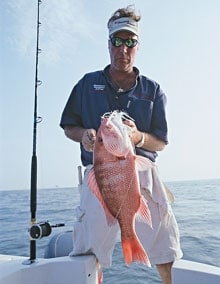
| |SNAP’S UP: A feisty red falls to a nylon Snapper Slapper jig. Photo: Robert Sloan| “Because you’re going to be jigging for grouper and big snapper around structure, you need a leader that can take some abuse,” says Marvel. “When I’m after large fish on the water, I work wrecks, rocks and rigs. I’ve got one helicopter wreck that’s always loaded with snapper and the occasional grouper. When I’m working a jig around that wreck a 400-pound-test leader is mandatory.”
Generally, leader strength is determined by the weight of the jig. For example, you don’t want to fish a three-ounce diamond jig with a 300-pound leader. It will kill the action of the lure. When targeting grouper and snapper around rigs and wrecks in 80 to 250 feet of water, I’ll be working three- to six-ounce jigs around some pretty abrasive bottom structure. With the three-ounce jigs, I’ll rig up with 80-pound-test Silver Thread shock leader. With the four- to six-ounce jigs, I’ll go with 100- to 130-pound-test leader. This particular leader material has a thin diameter and high abrasion resistance. Plus it’s not stiff like other leader materials. It’s critical to use a leader that is strong enough to pull fish away from structure. I like to use a ten- to 15-foot leader. That might sound crazy to some, but it’s helped to pull grouper and sow snapper away from stuff that would normally slice through monofilament fishing line.
I use an Albright special knot to join the 50-pound-test line to the leader. That way I have a wind-on leader. Make it a habit to run your fingers down the leader to feel for abrasions. It takes only a little time to replace a frayed leader that could cost a fish.
Jigging is easy once you get the hang of it, but some consider it an art form. You don’t just drop the jig to the bottom and casually pop it up and down. In almost every situation you’ll need to be aggressive. Once the jig is on the bottom, or at the desired depth, lower the rod, then jerk it up about two feet. From there follow the jig down with the rod tip. What you don’t want to do is take the action out of the free-falling jig by tight-lining it back down. As soon as the jig comes tight from the fall, jerk it back up again. Keep doing that until you get a bite-or need a break. Most of the time you want to keep a fairly fast rhythm going. The more action you give the jig, the better your chances are for getting an aggressive strike. Here’s another little tip: About 99 percent of the hits will come as the jig is falling, so always be alert.
“Grouper tend to have a more aggressive bite than snapper,” says Marvel. “They will inhale the spoon on the fall and head back to their hole. You’ll know when that happens.
You’ll almost get yanked out of the boat. That’s when you’ll need to really lean on the fish, otherwise it’ll be a short battle. The best possible situation is for the angler to work on turning the fish, while the boat is backing away from the structure.”
Because snapper don’t live in holes they will often take a jig while swimming around the structure.
Although turning them is not usually as difficult, it’s best to use a rod and reel with plenty of power whenever targeting snapper and grouper.
“I use a seven-foot Cape Fear rod that has plenty of backbone,” says Marvel. “My favorite jigging reel is a Shimano Dakota. Another good reel is the Shimano Speedmaster.”
At times, jigging for snapper and grouper is about as simple a form of fishing as exists. For anglers targeting giant fish, however, it’s all about sweating the small stuff and learning the subtleties of jig-and-bait combinations and jigging technique. Get it all right, and you can catch bigger snapper and grouper than you ever thought possible.
Jigmasters
Giant snapper and grouper are their bread and butter.
Captain Peace Marvel runs Reel Peace Charters out of Venice, Louisiana. Based out of Cypress Cove Marina, Marvel specializes in tuna trips and deep-water jigging for grouper and red snapper. For more information, call (985) 534-2278 or visit www.reelpeace.com.
Get-A-Way Adventures Lodge is located on the South Texas coast at Port Mansfield. They run excellent offshore trips for grouper and snapper over rocks, just a few miles off the beach. For more information, call (956) 944-4000 or visit www.getawayadventureslodge.com.





